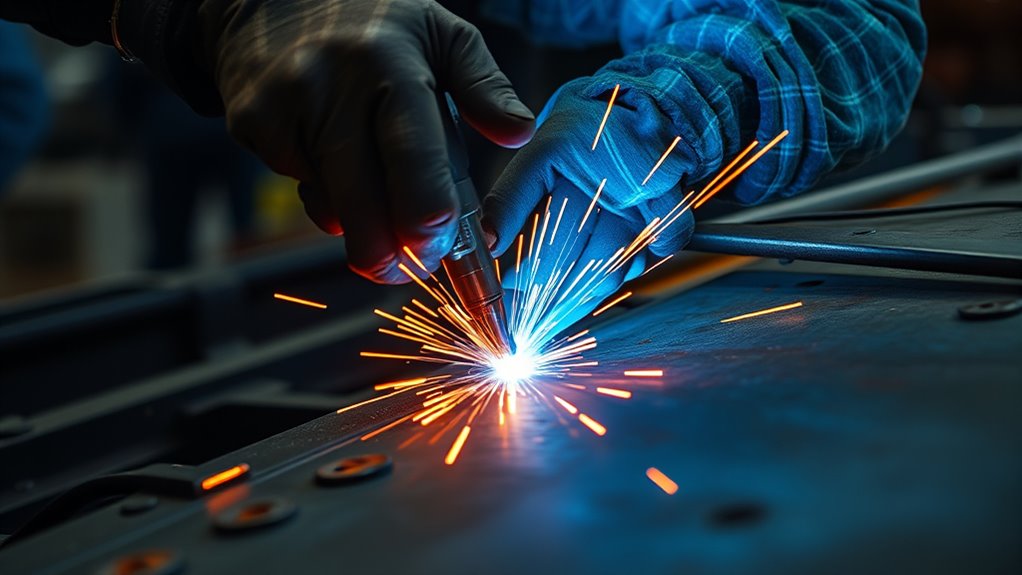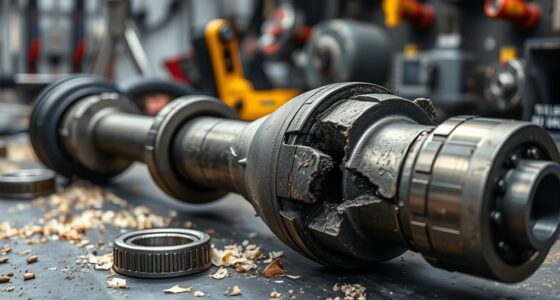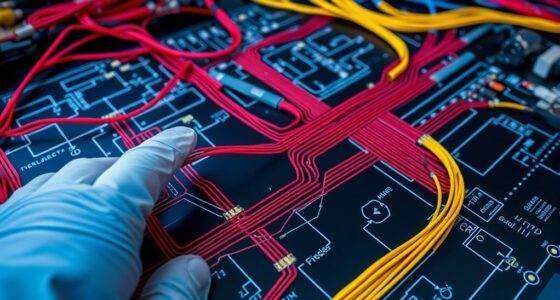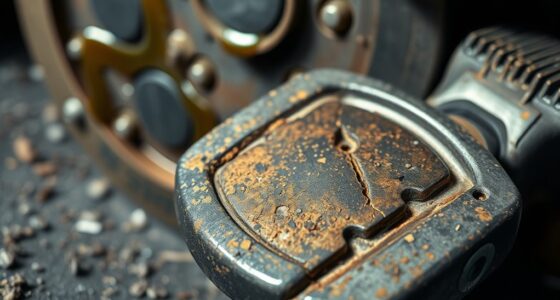To get started with welding in auto repair, focus on safety by wearing PPE like helmets, gloves, and protective clothing, and guarantee proper workspace ventilation. Choose the right technique—MIG for steel or TIG for aluminum—based on the metal you’re working with. Always clean your metal surfaces before welding to ensure strong joints. Understanding these basics helps improve weld quality and safety, and exploring more will give you even better skills for auto repair.
Key Takeaways
- Use appropriate PPE such as helmets, gloves, and protective clothing to ensure safety during welding.
- Select the correct welding technique (MIG or TIG) based on the metal type and repair requirements.
- Properly prepare metal surfaces by cleaning to improve weld quality and adhesion.
- Adjust welding parameters like heat settings according to the metal’s properties, such as aluminum’s high thermal conductivity.
- Maintain a safe workspace with adequate ventilation, fire safety measures, and free of flammable materials.
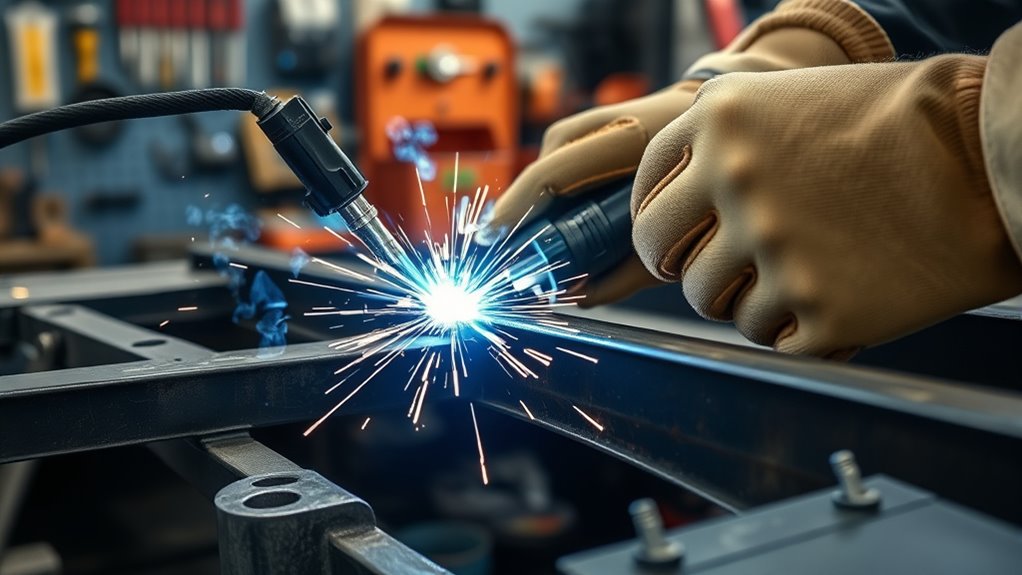
Welding is a fundamental skill in auto repair, allowing you to join metal components securely and restore vehicle integrity. Whether you’re fixing a rusted frame or attaching new panels, understanding welding basics is essential. However, safety should always come first. Welding safety involves wearing appropriate personal protective equipment, such as welding helmets, gloves, and protective clothing, to shield yourself from intense heat, UV radiation, and sparks. Adequate ventilation is *imperative* to prevent inhaling harmful fumes generated during welding. Make sure your workspace is well-ventilated and free of flammable materials. Also, familiarize yourself with fire safety procedures and have a fire extinguisher nearby. Proper safety practices not only protect you but also *guarantee* the quality of your welds.
When it comes to welding auto bodies and frames, understanding the different metal types you’ll encounter is *indispensable*. Common metals in auto repair include steel, aluminum, and sometimes stainless steel. Steel is the most prevalent, offering strength and durability; however, it requires specific welding techniques and consumables. Aluminum, used increasingly in modern vehicles for weight reduction, demands a different approach due to its thermal conductivity and melting point. You need to select the right welding process and filler material tailored to each metal type. For steel, MIG welding is often the go-to method, providing fast, clean results with the right wire and shielding gas. Aluminum, on the other hand, typically requires TIG welding, which offers precision and control necessary for thinner, more delicate parts. Knowing the properties of each metal—such as melting point, thermal expansion, and conductivity—helps you choose the appropriate welding parameters and equipment, *ensuring* strong, reliable joints.
Additionally, understanding the characteristics of different metals helps you avoid common pitfalls like warping, cracking, or incomplete fusion. For example, aluminum’s high thermal conductivity means it cools quickly, so you need to adjust your heat settings accordingly. Steel’s higher melting point makes it more forgiving, but you must still control heat input to prevent burn-through. Proper preparation of the metal surfaces—cleaning off rust, paint, and dirt—is *crucial* for good weld quality. Using the right welding safety measures and knowing the specific metal types you’re working with will make your auto repairs safer and more effective. With experience, you’ll get better at adjusting your technique based on the metal, *guaranteeing* durable repairs that stand the test of time.
Frequently Asked Questions
What Safety Gear Is Essential for Auto Welding?
You need essential safety gear like protective clothing to shield your skin from sparks and heat, and eye protection to guard against intense UV rays and debris. Wear a welding helmet with a proper filter shade, along with gloves and long sleeves to prevent burns. Make certain your clothing is flame-resistant, and always work in a well-ventilated area. This gear keeps you safe while you focus on doing quality auto welding.
How Do I Choose the Right Welding Machine for Auto Repairs?
Picture yourself selecting a trusty steed for a long journey. To choose the right welding machine for auto repairs, consider your welding techniques and the metal you’ll work with. Look for versatile machines with adjustable settings, capable of handling different thicknesses and materials. Proper metal preparation enhances weld quality, so choose a machine that offers precision and control. This way, you’ll guarantee strong, reliable repairs every time you hit the shop.
Can I Weld Aluminum Auto Parts at Home?
Yes, you can weld aluminum auto parts at home, but it requires proper equipment and techniques. Aluminum welding demands a specialized welder, like a TIG welder, and the right shielding gas to prevent oxidation. Make certain you practice safety and have good ventilation. With patience and the right tools, home welding aluminum auto parts is achievable, allowing you to repair or modify your vehicle efficiently.
What Are Common Welding Mistakes in Auto Repair?
You might think you’re a welding prodigy, but common mistakes like neglecting proper welding technique or choosing the wrong electrode can sabotage your repair. Don’t skip evaluating your electrode selection or rushing the process. Failing to clean surfaces, overheating, or inconsistent technique creates weak welds. Pay attention, follow proper procedures, and practice patience—otherwise, your auto repair could turn into a costly lesson in what not to do.
How Do I Prevent Rust After Welding on a Car?
To prevent rust after welding, you should apply a rust prevention treatment or primer to the welded area promptly. Then, use protective coatings like paint, sealants, or undercoatings to shield the metal from moisture and corrosion. Make sure the surface is clean and dry before applying these coatings. Regularly inspect and touch up any chipped or damaged areas to maintain long-term rust protection and keep your vehicle in top condition.
Conclusion
Now that you’ve mastered these welding basics, you’re practically a superhero in auto repair! With just a little practice, you’ll be able to fix anything from tiny cracks to major frame damage faster than you can say “auto magician.” Your new skills will save you time, money, and maybe even a few broken nails. Get ready to take on every repair with confidence—your toolbox is about to become your secret weapon!
